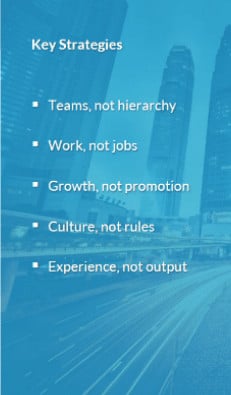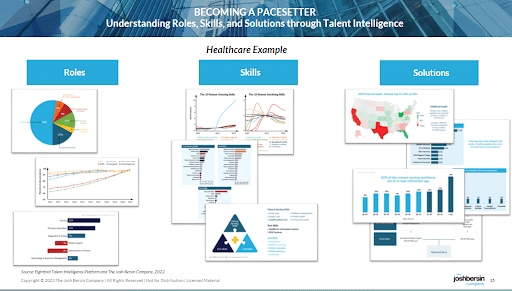Despite widespread layoffs in the tech industry, affected workers are quickly finding new homes for their digital skills — just not in the same industry. That’s because, in many ways, every organization has become a tech company and is looking for new ways to boost their talent strategies and meet their growing digital needs. Retail and banking companies have mobile apps; health care companies offer telehealth, and so on.
As the digital revolution continues, organizations are reinventing themselves, branching into new products and services, and not just in banking and health care. Disney has become a frontrunner in streaming, Walmart has expanded into health delivery, Mercedes-Benz into energy distribution, and AT&T into movies and entertainment.
Amid this widespread industry and digital transformation, 40% of CEOs doubt their company will survive another decade without fundamental change. The majority of these organizations are too bogged down in daily activities to focus on future planning or transformation. To survive, HR teams must adopt a new operating system focused on skills, where every element of HR is interconnected.
In a recent webinar, The Josh Bersin Company’s Kathi Enderes, SVP, Research and Global Industry Analyst, and Stella Ioannidou, Research Director, shared exclusive research from Josh Bersin’s Global Workforce Intelligence Project — industry insights detailing the top strategies top-performing companies use across each area of Bersin Company’s 4R Framework — recruit, retain, reskill, and redesign. They call these top-performing organizations “pacesetters,” and they are not just leading the industry now, but also advance their lead exponentially.

Source: The Josh Bersin Company, 2022
Related content: Do you know how ChatGPT could impact your industry? Learn more about ChatGPT and the Future of Work with our latest report.
Strategies of top-performing companies
1. Focus on organizational design, accountability, and goal systems that facilitate change and efficiency
Pacesetters deploy talent where it’s needed most. In banking, for example, mobile apps have become a differentiator. Pacesetter banks have 1.3x more people in IT operations and 1.6x fewer people in middle- and back-office roles. In this regard, they more closely resemble fintech companies. These might not seem like big numbers, but for the average bank, this nets out to around 3,500 more people in IT operations and 4,000 fewer employees in office roles — a crucial advantage in developing competitive digital offerings.
2. Prioritize technology and transformation roles as much as key operational roles
Organizations can’t always hire more workers to acquire the right skills — they simply might not exist. This is prevalent in health care where the biggest problem is no longer financial pressure — like it has been for the last 17 years. It’s a growing nursing shortage. Health care pacesetters overcome this challenge through technology and automation.
As Enderes explained, “Why do the pacesetters have five times more web developers? Well, they use technology to free up their nurses’ time. On average, nurses only spend 40 to 50% of their time — sometimes even less — on what they call top-of-license work — the work they’re uniquely qualified for. The rest of their time is spent documenting, charting, giving discharge procedures or medication, and doing all of the things that either technology could do or a lower-level person could do.” With the help of technology and automation, health care pacesetters can accomplish the same level of work with 20% fewer nurses.
3. Invest in cutting-edge skills in technology, transformation, and consultative HR, constantly experimenting with new approaches
In health care, pacesetters have 2.5x more HR tech skills and 5.25x more Python skills than competitors. Why? Top-performing companies look ahead to see which skills are trending upward and which they’ll soon need. Then, they act accordingly to ensure they’re not scrambling to find these skills when the talent market becomes red hot.
4. Deeply value talent and prioritize mobility, retention, and reskilling to drive growth rather than depending on recruiting alone
With U.S. unemployment rates at a 53-year low of 3.4%, pacesetters don’t rely on hiring alone to acquire in-demand skills. After they’ve gained an accurate assessment of the skills they have and the skills they’ll need soon, they prioritize ways to acquire those skills for the long run, whether that’s through retention, upskilling, reskilling, or all of the above.
5. Continuously redesign jobs and employment models to adapt for the future
The Josh Bersin Company identified a gap of 2.1 million nurses that could be shored up by 2025. A huge part of what makes this possible comes from healthcare redesigning their jobs and employment models. During the pandemic, scores of nurses left their organizations due to stress and burnout.
Mercy Health, a pacesetter in health care, created an app that allowed its nurses to choose how much or little they wanted to work each week, something unheard of in the hardworking medical world known for its long hours. Not only did this greatly boost the retention of nurses, but it also served as a powerful attraction tool that helped them hire more nurses.

Source: Eightfold Talent Intelligence Platform and The Josh Bersin Company, 2022
6. Implement a globally integrated, systemic HR operating model
Not every pacesetter will optimize its operating model in the same way. For example, ING Bank, one banking pacesetter The Josh Bersin Company studied prioritized agility — their operating model looking more like Spotify’s than a bank — while another one, DBS Bank, focused on becoming digital first. Both saw great results.
But while there are different approaches companies can use to achieve success, there are common operating models when it comes to HR. Specifically, pacesetters prioritize teams, not hierarchy. They organize around the work that needs to be done, focus on the employee experience, and empower their talent to grow — not just through promotions, but also through learning, upskilling, and reskilling.

Source: The Josh Bersin Company, 2022
7. Collaborate across the C-Suite
CHROs can work on systemic HR practices within HR, but they can’t transform the organization alone. The CEO needs to influence national, state, and local policy and serve as the sponsor of transformation. The CFO needs to be on board from an investment perspective. The CIO needs to provide technology enablement for the organization’s workers. The COO should set the stage for operational enablement. The entire C-Suite has to be all in, and seamlessly aligned.
Set the bar in your industry
To become a pacesetter, you must have a deep understanding of the roles and skills in your workforce. You have to see how they relate to one another and what’s happening to those skills in your industry in real time.
The Josh Bersin Company uses the Eightfold Talent Intelligence Platform to gain this in-depth view of skills — past, present, and future — with in-depth time series analyses based on billions of global talent data points. Eightfold’s platform provides unrivaled insights into your workforce and the industry at large so you can recruit the right talent, exceed diversity goals, retain top performers, and upskill and reskill your workforce with a single solution for all your talent needs.

Source: The Josh Bersin Company, 2023
Watch the entire webinar, “Leading talent strategies of pacesetters: Exclusive industry insights from Josh Bersin’s Global Workforce Intelligence Project,” to learn more about how the top 10% of companies outperform their competition and shape the future of work.










